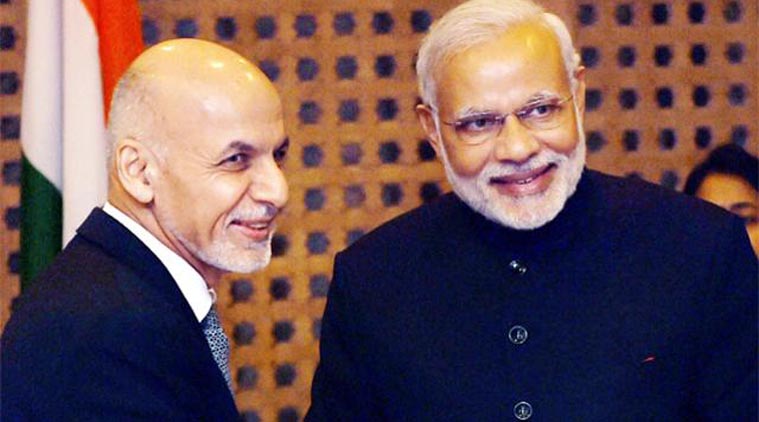India-Afghanistan Freeze Thaws with Ghani's Visit?
Ghani and Modi

NEW DELHI: Afghan President Ashraf Ghani is in New Delhi on his first state visit to India. The chattering classes are excited, as the media churns out story after story on how this visit “has dispelled all apprehensions of a chill in the relationship between the two countries."
Ghani and his Indian counterpart, Prime Minister Narendra Modi, seem to agree. “Afghanistan and India are two countries that are bound by a thousand ties and millions of memories,” Ghani said at a joint address to the media after a meeting with PM Modi. "The relationship between India and Afghanistan is not just between two countries or governments. It is a timeless link of human hearts," said Modi, adding that “India will walk shoulder to shoulder with you and Afghan people.”
As the two countries vow to boost trade, cooperate on terrorism and promote defence ties, opinion makers in India who have long been gunning for an enhanced role in Afghanistan smile ear to ear. India, finally, seems to be taking the possibility of a strategic presence in Afghanistan seriously. This is important, these opinion-makers -- professional and self styled -- reaffirm. It is important to control the situation in historically uncontrollable Afghanistan lest it spill over into India, they say.
These opinion makers add that the time is right for India to increase its role in Afghanistan. With the United States set to retreat from Afghanistan, there is space for a regional player, they say. This regional player can and should be India, given Pakistan’s disruptive role in the region, they conclude.
There is perhaps a measure of truth in the fact that the US, looking to pull out of Afghanistan militarily and financially, is keen on passing the can to another player. Historically, this player for the US in the region has been Pakistan, but recent developments centred on Pakistan’s own troubled economy and polity, has created political entry space for India.
And India has certainly tried. India has flexed its soft power muscles in Afghanistan, emerging as one of the leading donor nations, with aid standing at $2 billion. India has invested in hospitals, institutional buildings, including Afghanistan’s parliament, educational institutions, and signed accords to train army and police officers, amongst other capacity building measures.
The question worth asking, however, is why should India concern itself with Afghanistan? The contention that trouble in Afghanistan can spill over into India is tenuous, given that the two countries do not share a border.
More significantly, intervening in Afghanistan will possibly have disastrous consequences for India. The country, with a population of 29.83 million people, has a GDP of $26 billion -- making it one of the poorest countries in the world. What the GDP is made up of is even more worrying. About 35% of Afghanistan’s GDP is due to grants from western sources, Saudi Arabia and in part from countries like India.
As Mohan Guruswamy wrote in a previous article for The Citizen: “Since 2002, the USA has expended about $100 billion on non-military aid to Afghanistan, but during the same period it has also spent $642 billion on military operations in Afghanistan. Afghanistan’s own revenues account for less than 10% of its GDP. Quite clearly, without this continued burn rate of western aid Afghanistan’s GDP will undergo a massive contraction, something few countries can emerge from without irrevocably and irretrievably changing. Just not to fall off the treadmill Afghanistan needs an annual grant-in-aid package of about $12 billion. Military operations will cost much more. Of this, only Germany has made a commitment of about $587 million annually, but only till 2016.”
The bad news continues. The total exports from Afghanistan are estimated to be about $2.5 billion a year, of which illegal opium trade accounts for a whopping $2 billion. Opium cultivation in the country has risen to record highs, with the United Nations Office on Drugs and Crime (UNODC) concluding that cultivation rose seven percent over the 2013 figure to account for 90 percent of the world's heroin supply. The US/NATO war in Afghanistan has directly contributed to the increase in opium cultivation, with the total area under opium cultivation in the Taliban period being a mere 3000 hectares; today, 224,000 hectares (553,500 acres) of land in Afghanistan is used for opium cultivation.
The total value of “legal” exports from Afghanistan are about $376 million, of which $154 million is to India and most of the rest is to Pakistan. As Guruswamy wrote, “Afghanistan now imports almost seventeen times that, which leaves it with a trade deficit of $8.52 billion. But with the grant munificence Afghanistan has a positive Current Account Balance of 1.7% of GDP. This further underscores the dependence on grants-in-aid.”
Add to this the insurgency in Afghanistan, which claimed a record number of civilians lives in 2014, and the dismality of the situation becomes more evident. The UN Mission in Afghanistan noted that the number of civilians killed or wounded in the troubled country climbed by 22 percent in 2014 to reach the highest level since 2009. The UN agency documented 10,548 civilian casualties in 2014, the highest number of civilian deaths and injuries recorded in a single year since 2009. They include 3,699 civilian deaths, up 25 per cent from 2013 and 6,849 civilian injuries, up 21 per cent from 2013. Since 2009 -- when UNAMA began tracking casualties -- the armed conflict in Afghanistan has caused 47,745 civilian casualties with 17,774 Afghan civilians killed and 29,971 injured. The UN says that Taliban militants -- who have been waging an insurgency in Afghanistan since a US-led invasion toppled their government 13 years ago -- were responsible for 72 per cent of all civilian casualties, with government forces and foreign troops responsible for 14 percent.
It is of no surprise, therefore, that the US is ready to pass the buck. The question is: should India jump at the chance of receiving it?



